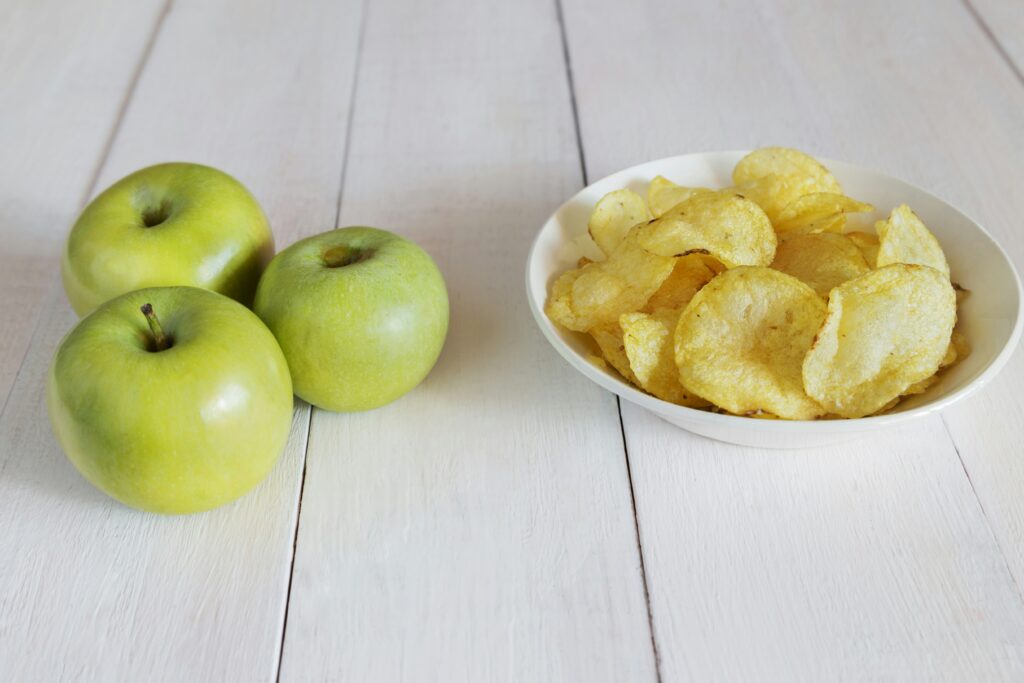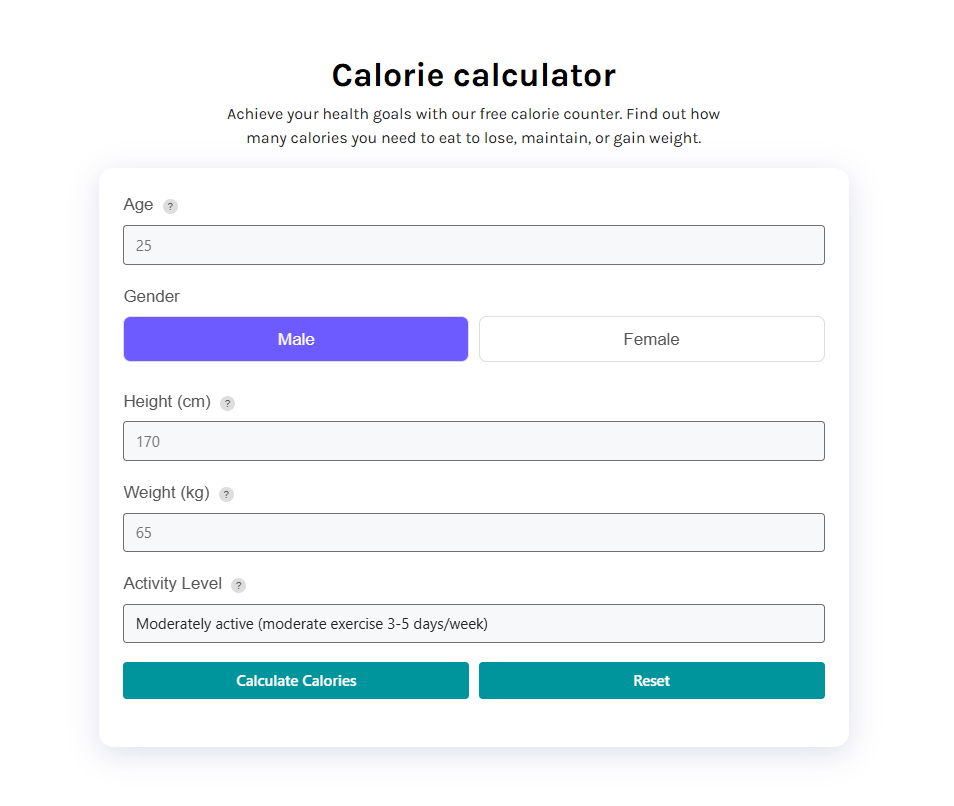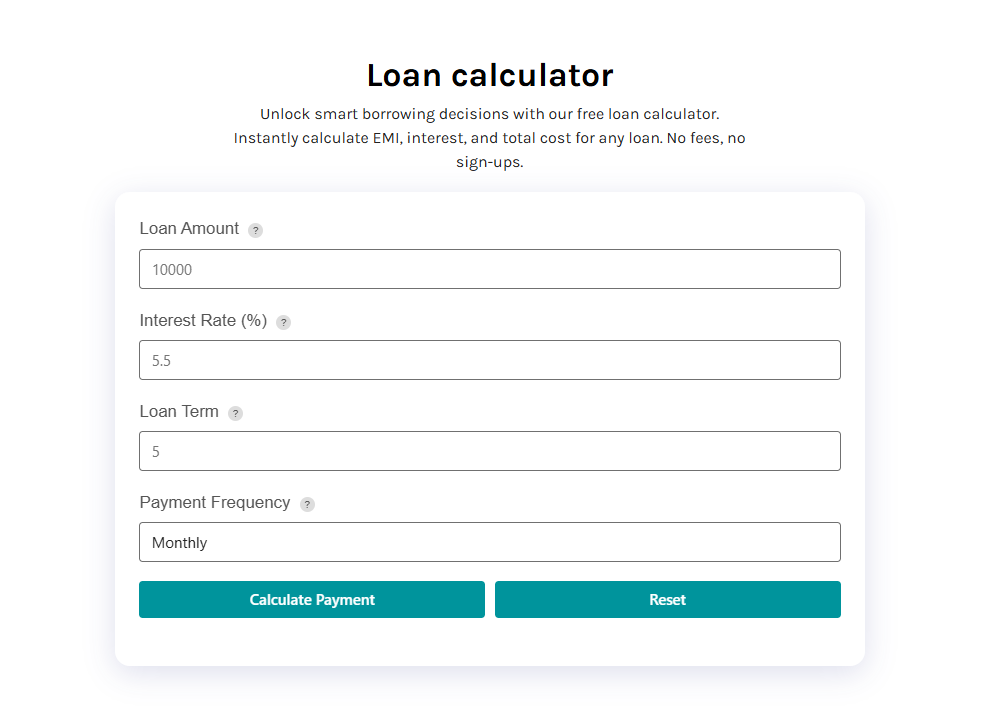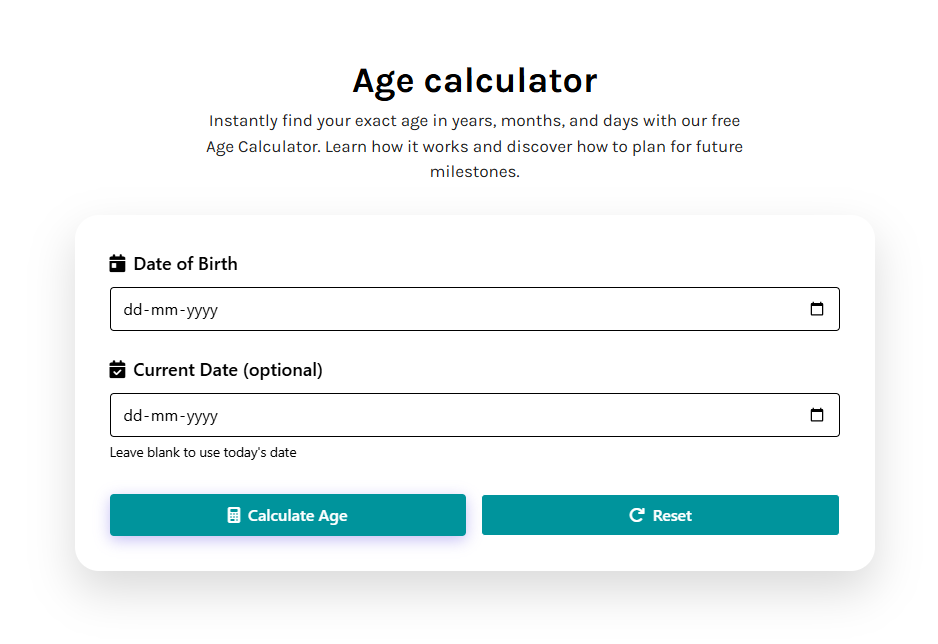Are you tired of the endless cycle of fad diets? One week it’s no carbs, the next it’s only cabbage soup. It’s confusing, frustrating, and, let’s be honest, pretty miserable. You see people successfully losing weight and keeping it off, and you wonder, “What’s their secret?”
Well, what if I told you the “secret” isn’t a secret at all? It’s not a magic pill or a punishing workout plan. It’s math. Simple, straightforward math.
Welcome to the ultimate guide on using a calorie calculator to find your perfect, sustainable weight loss deficit. Forget the guesswork. Forget the starvation diets. By the end of this article, you’ll understand exactly how your body uses energy and how you can leverage that knowledge to finally achieve your weight loss goals in a healthy and empowering way.
We’re going to break it all down—the science, the strategy, and the simple steps you can take starting today. Ready to take control? Let’s dive in.
What in the World is a Calorie, Anyway?
Before we can count them, we need to know what we’re dealing with. We hear the word “calorie” thrown around constantly, usually with a negative spin. But calories aren’t the enemy!
A calorie is simply a unit of energy.
Think of your body like a car. To drive from your house to the store, your car needs fuel (gasoline). To perform every single action—from blinking and breathing to running a marathon—your body needs fuel (calories). We get these calories from the food and drinks we consume.
- Carbohydrates provide 4 calories per gram.
- Proteins provide 4 calories per gram.
- Fats provide 9 calories per gram.
That’s it! A calorie isn’t a physical thing you can hold. It’s a measurement of the energy potential locked inside your food. Your body needs this energy to survive and thrive. The problem only arises when we consistently give our bodies more fuel than they need to operate.
The Unshakeable Science of Weight Loss: Calories In vs. Calories Out (CICO)
At its core, weight management operates on a simple principle of energy balance. This is often called the “Calories In, Calories Out” or CICO model.
- Calories In: The total energy you consume from food and drink.
- Calories Out: The total energy your body burns throughout the day.
This creates three possible scenarios:
- Weight Maintenance (Energy Balance): You eat roughly the same number of calories that your body burns. Your weight stays stable.
- Weight Gain (Calorie Surplus): You eat more calories than your body burns. The excess energy is stored for later, primarily as body fat.
- Weight Loss (Calorie Deficit): You eat fewer calories than your body burns. Your body needs to find that missing energy somewhere, so it turns to its stored reserves (body fat) to make up the difference.
This is the fundamental law of thermodynamics applied to your body. To lose weight, you must be in a calorie deficit. A calorie calculator is the most powerful tool to figure out exactly what your “Calories Out” number is, so you can intelligently plan your “Calories In.”
The Main Event: How a Calorie Calculator Works Its Magic
An online calorie calculator isn’t just pulling a random number out of thin air. It uses established scientific formulas to estimate your body’s daily energy needs. It does this by figuring out two key numbers: your Basal Metabolic Rate (BMR) and your Total Daily Energy Expenditure (TDEE).
Let’s pull back the curtain and see how it’s done.
Basal Metabolic Rate (BMR): Your “Coma Calories”
Imagine you’re lying in bed all day, not moving a muscle. You’re awake, but you’re not doing anything—no walking, no talking, no digesting. Your body is still incredibly busy! Your heart is pumping, your lungs are breathing, your brain is firing, and your cells are repairing themselves.
The amount of energy required to perform these basic, life-sustaining functions is your Basal Metabolic Rate (BMR). Think of it as the number of calories you’d burn if you were in a coma. It’s the absolute minimum energy your body needs to stay alive.
Your BMR is influenced by several factors:
- Age: BMR tends to decrease as you get older.
- Sex: Men generally have a higher BMR than women due to higher muscle mass.
- Weight: The heavier you are, the more energy your body needs to function.
- Height: Taller individuals typically have a higher BMR.
- Body Composition: Muscle tissue burns more calories at rest than fat tissue.
Calculators use formulas like the Mifflin-St Jeor or Harris-Benedict equations to estimate your BMR based on the stats you provide.
Total Daily Energy Expenditure (TDEE): Your Real-World Burn
Nobody lies in bed all day (at least, we hope not!). Your BMR is just the starting point. To get your true daily calorie burn, we need to account for all your physical activity. This total number is your Total Daily Energy Expenditure (TDEE).
The formula is simple: TDEE = BMR x Activity Level
This is where you have to be honest with yourself! A calorie calculator will ask you to select your activity level. This multiplier is what turns your baseline BMR into a practical, real-world number.
Here’s a typical breakdown of those activity levels:
| Activity Level | Description | Multiplier |
| Sedentary | Little to no exercise. You have a desk job and spend most of your free time sitting. | BMR x 1.2 |
| Lightly Active | Light exercise or sports 1-3 days a week. You walk a fair bit at work or for leisure. | BMR x 1.375 |
| Moderately Active | Moderate exercise or sports 3-5 days a week. You’re consistently active. | BMR x 1.55 |
| Very Active | Hard exercise or sports 6-7 days a week. You have a physically demanding job or train intensely. | BMR x 1.725 |
| Extra Active | Very hard exercise, a physically demanding job, and you train. For elite athletes or laborers. | BMR x 1.9 |
Choosing the right activity level is crucial. Overestimating your activity is one of the most common reasons why people struggle to lose weight even when they think they’re in a deficit. When in doubt, it’s often better to choose the lower of two options.
You’ve Got Your TDEE Number… Now What?
Okay, the calorie calculator has given you a number. Let’s say your TDEE is 2,500 calories. This is your “maintenance” level. If you eat 2,500 calories per day, your weight will stay the same.
To lose weight, you need to eat less than this. You need to create your perfect deficit.

The Golden Rule: Slow and Steady Wins the Race
You might be tempted to slash your calories dramatically. If 2,500 is maintenance, maybe 1,200 is better, right? Wrong.
An overly aggressive deficit is a recipe for disaster. It can lead to:
- Muscle Loss: Your body might start breaking down precious muscle tissue for energy, not just fat.
- Nutrient Deficiencies: It’s hard to get all the vitamins and minerals you need on very low calories.
- Metabolic Adaptation: Your body can slow down its metabolism to conserve energy, making weight loss harder.
- Fatigue and Irritability: You’ll feel terrible, lack energy, and be more likely to give up.
- Binge Eating: Extreme restriction often leads to extreme binges, undoing all your progress.
A Practical Guide to Setting Your Daily Calorie Goal
A safe, sustainable, and effective rate of weight loss is about 1-2 pounds (0.5-1 kg) per week.
- To lose 1 pound of fat, you need to create a cumulative deficit of approximately 3,500 calories.
- To lose 1 pound per week, you need a daily deficit of 500 calories (500 calories/day x 7 days/week = 3,500 calories/week).
This is the sweet spot. A 500-calorie deficit is noticeable enough to produce results but not so drastic that it leaves you feeling deprived and exhausted.
Let’s use our example:
- Your TDEE is 2,500 calories.
- You want to create a 500-calorie deficit.
- 2,500 – 500 = 2,000 calories.
- Your new daily calorie target for weight loss is 2,000 calories.
For a slower, gentler approach, you could aim for a 250-300 calorie deficit, which would result in about half a pound of weight loss per week. This is a fantastic option for those with less weight to lose or who want to prioritize workout performance.
It’s Not Just How Many Calories, But What Kind
Could you lose weight by eating 2,000 calories of only cookies? Technically, for a while, yes—if your TDEE is 2,500. But you would feel absolutely awful, lose muscle, and be incredibly unhealthy.
The quality of your calories matters immensely for your health, body composition, and satiety (how full and satisfied you feel). This is where macronutrients come in.
Protein: The Muscle-Sparing Hero
When you’re in a calorie deficit, protein is your best friend. It’s the most satiating macronutrient, meaning it helps you feel fuller for longer. More importantly, getting enough protein helps signal to your body to preserve lean muscle mass while burning fat for energy. Aim to include a source of lean protein with every meal.
- Sources: Chicken breast, turkey, fish, eggs, Greek yogurt, cottage cheese, tofu, beans, lentils, protein powder.
Carbohydrates: Your Body’s Preferred Fuel
Carbs have been unfairly villainized. They are your brain and body’s primary and most easily accessible source of energy. They fuel your workouts and provide essential fiber for digestive health. The key is to choose complex, whole-food sources over simple, sugary ones.
- Sources: Oats, brown rice, quinoa, potatoes, sweet potatoes, whole-grain bread, fruits, and vegetables.
Fats: More Than Just a Villain
Dietary fat is essential for hormone production, vitamin absorption, and overall health. Like carbs, the source matters. Focus on unsaturated fats and limit saturated and trans fats. Fats are very calorie-dense (9 calories per gram), so portion control is important.
- Sources: Avocado, nuts, seeds, olive oil, fatty fish (like salmon).
A balanced approach that includes all three macronutrients is the key to a sustainable and healthy diet.
Beyond the Calculator: 10 Practical Tips for Success
Knowing your calorie target is one thing; hitting it consistently is another. Here are ten real-world tips to make your calorie deficit journey a success.
- Use a Tracking App: For the first few weeks, meticulously track everything you eat using an app like MyFitnessPal or Cronometer. This is an educational process. You’ll be shocked to learn where hidden calories are lurking (that salad dressing, the oil you cook with, the splash of cream in your coffee).
- Read Nutrition Labels: Become a detective in the grocery store. Pay attention to serving sizes. A bag of chips might say 150 calories, but if the serving size is 10 chips and you eat the whole bag, you’ve consumed far more.
- Don’t Drink Your Calories: Sodas, sugary juices, fancy coffee drinks, and alcohol are often loaded with calories but provide little to no nutritional value or satiety. Stick to water, black coffee, and unsweetened tea.
- Prioritize Protein and Fiber: Build your meals around lean protein and high-fiber vegetables. This combination will keep you feeling full and satisfied, making it much easier to stick to your calorie goal.
- Plan and Prep Your Meals: When you’re hungry and have nothing prepared, it’s easy to reach for high-calorie convenience foods. Dedicate a few hours on the weekend to plan your meals, shop, and prep ingredients.
- Practice Mindful Eating: Slow down. Savor your food. Pay attention to your body’s hunger and fullness cues. Turn off the TV and put away your phone while you eat. You’ll often find you feel full with less food.
- Get a Food Scale: It might seem extreme, but a food scale is the most accurate way to learn what proper portion sizes look like. Your idea of a “tablespoon” of peanut butter might actually be three!
- Stay Hydrated: Sometimes our brains mistake thirst for hunger. Before reaching for a snack, drink a large glass of water and wait 15 minutes. You might find the “hunger” disappears.
- Allow for Flexibility: A rigid, perfect diet is a brittle one. Plan for foods you love. If you want a slice of pizza, work it into your calorie budget for the day. This “80/20” approach (80% whole foods, 20% treats) prevents feelings of deprivation and makes the process sustainable long-term.
- Incorporate Movement: While diet is the primary driver of weight loss, exercise is a powerful partner. It increases your “Calories Out,” builds muscle (which boosts your BMR), and has incredible benefits for your mental and physical health.
Common Roadblocks and How to Navigate Them
The path to weight loss isn’t always a straight line down. Here are some common issues and how to troubleshoot them.
“Help! I’m in a Deficit But the Scale Isn’t Moving!”
Don’t panic! This is incredibly common. Here are a few potential culprits:
- Water Weight Fluctuations: Your weight can fluctuate by several pounds daily due to hydration levels, sodium intake, carb intake, and hormonal cycles. Look at the weekly trend, not the daily number.
- Inaccurate Tracking: Are you really tracking everything? The little bites, the cooking oils, the weekend splurges? Be honest with your tracking for a week and see if there are any “calorie leaks.”
- Overestimating Your Activity Level: As mentioned before, this is a big one. You might need to adjust your TDEE calculation to a lower activity level.
- The Plateau: It’s normal for weight loss to stall after a few weeks or months. Your body is adapting. This might be a sign to slightly decrease your calories, increase your activity, or take a “diet break” for a week by eating at your maintenance calories to give your body a rest before resuming your deficit.
The “All-or-Nothing” Trap
You ate a cookie that wasn’t in your plan. You think, “Well, I’ve already ruined my diet for today, might as well eat the whole box!” This black-and-white thinking is destructive.
One cookie is not a disaster. One off-plan meal is not a disaster. Simply acknowledge it, enjoy it, and get right back on track with your next meal. Consistency over perfection is the name of the game.
Forgetting About Non-Scale Victories (NSVs)
The scale is just one data point. Obsessing over it can be demoralizing. Pay attention to all the other amazing signs of progress:
- Your clothes are fitting looser.
- You have more energy throughout the day.
- You’re sleeping better.
- You can lift heavier weights or walk further without getting tired.
- Your skin looks healthier.
- You feel more confident.
Celebrate these victories! They are just as important—if not more so—than the number on the scale.

Conclusion: Your Journey, Your Numbers, Your Success
A calorie calculator is not a dictator. It’s a compass. It gives you a starting point and a direction, but you are still the captain of your ship. It demystifies the process of weight loss, transforming it from a confusing guessing game into a clear, actionable plan.
By understanding the energy balance of your unique body, you can finally ditch the restrictive fad diets and build a healthy relationship with food. You can fuel your body properly, create a gentle and sustainable deficit, and watch as your hard work pays off.
Use the knowledge you’ve gained here. Find your numbers, track your intake, prioritize nutritious foods, and be patient with yourself. This is a journey of health, not a race to a number. You’ve got this.
Frequently Asked Questions (FAQs)
1. How accurate are online calorie calculators?
Online calorie calculators provide a very good estimate based on scientific formulas. However, they are not 100% accurate because they can’t account for individual genetic and metabolic differences. The best way to use a calculator is as a starting point. Follow the recommended calorie target for 2-3 weeks. If you’re losing weight at the desired rate, it’s a good number for you! If not, adjust your daily intake up or down by 100-200 calories and assess again.
2. What is a safe calorie deficit for weight loss?
A safe, sustainable, and effective calorie deficit is generally between 300 and 500 calories below your Total Daily Energy Expenditure (TDEE). This typically results in a weight loss of about 0.5 to 1 pound per week. Drastic deficits of more than 500-700 calories can lead to muscle loss, fatigue, and nutrient deficiencies and are not recommended without medical supervision.
3. Do I need to track calories forever to maintain my weight?
No, most people do not need to track calories meticulously for the rest of their lives. The initial tracking phase is an invaluable educational tool. It teaches you about the calorie density of different foods, what appropriate portion sizes look like, and how to build satisfying, healthy meals. After a while, you will be able to eat intuitively, maintaining your weight by applying the principles you learned without needing to log every single item.
4. Can I eat whatever I want as long as I’m in a calorie deficit?
Technically, you can lose weight by eating only junk food if you remain in a calorie deficit (the principle of CICO). However, this is a very poor strategy for overall health. The quality of your calories matters for satiety, energy levels, muscle retention, and getting essential vitamins and minerals. A balanced diet rich in protein, fiber, and micronutrients will make it much easier to stick to your deficit and will support your overall well-being.
5. Should I recalculate my calorie needs as I lose weight?
Yes, absolutely. As you lose weight, your body requires fewer calories to maintain itself (your BMR and TDEE will decrease). It’s a good practice to recalculate your TDEE and adjust your calorie target after every 10-15 pounds (or 5-7 kg) of weight loss. This ensures you continue to be in an effective deficit and helps you push past weight loss plateaus.


